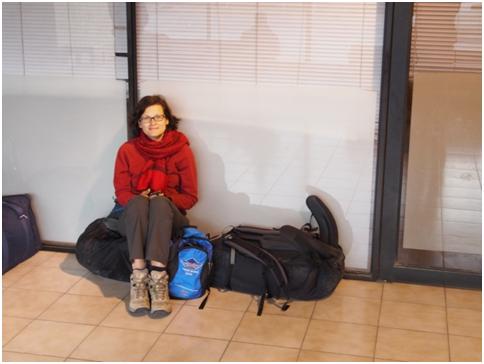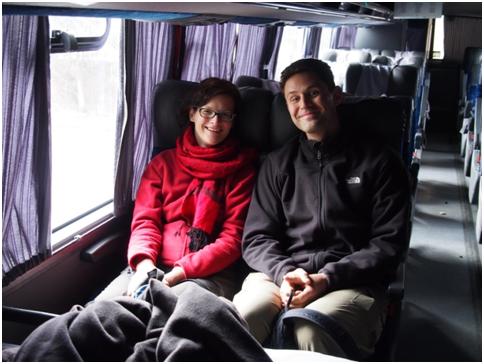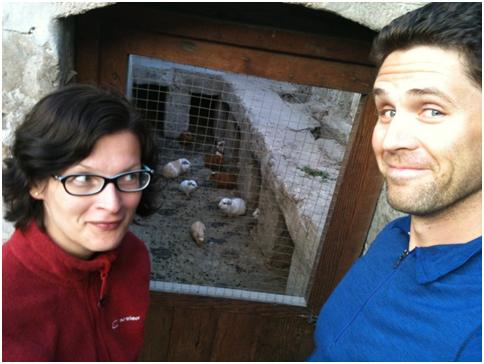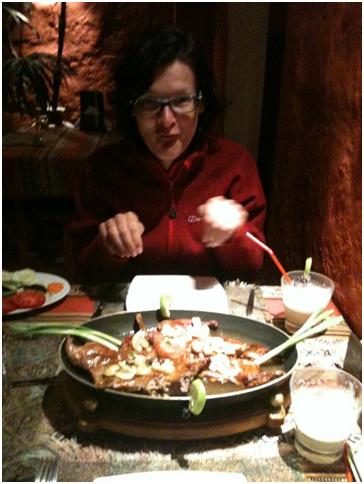The Salar de Uyuni. No fun AT ALL to get to; has to be seen to be believed.

Words can't quite describe this one. Let's just say "it actually exists".

The Salar de Uyuni. No fun AT ALL to get to; has to be seen to be believed.

Words can't quite describe this one. Let's just say "it actually exists".
So why, I hear you ask, did you put James through that horrific experience of the night bus to Calama / en route to San Pedro de Atacama?
Well…. I was easing him in gently.
Tom and Cerys - Magic. And yes, it was. Very.
San Pedro is the nicer of the two places where one can arrange a 3 day jeep tour taking in the sights of deepest darkest southwest Bolivia, including the amazing Salar de Uyuni (the other place being Uyuni, which is where we are now. Even a rather nice chocolate tart in a relatively civilized bar have in no way changed my opinion that Uyuni is, in simple essence of the fact, a complete hole). The Salar de Uyuni had been one of the top items on James’ wish list when we first started planning the trip, so it was a dead cert for our time in South America. Unfortunately, the 3 day jeep tour, whilst being absolutely, wildly spectacular, I remembered from last time as being one of the most fundamentally basic of all my experiences within the continent (and I wasn’t exactly living the high life last time I went round this neck of the woods either). Whilst the scenery had faded for me over the years, the biting cold, the altitude sickness (4,900 metres at the journey’s highest point), the jowl shaking ride and the existence of the one singular town toilet in one of the little communities we stayed at are seemingly indelibly etched in the old memory banks. Bolivia being a pretty hardened opponent to progress in any fashion, I feared little would have changed.
How wrong I was. BOTH of the communities we visited had more than one toilet. Inside no less. Luxury.
It remains, however, a long and fairly arduous journey, made more so in our case by the fact that our carefully selected tour operator didn’t have enough people and therefore ditched us (without actually telling us so) on another, slightly less carefully selected tour group. Six of us in a jeep built for five. Rice for lunch when others got a gourmet feast. A hostel run by the least friendly, and largest Bolivian lady I have EVER seen though I still don’t know how she managed that living in the middle of the DESERT (when she bent over, owing to the Bolivian custom of wearing knee length gathered skirts and short socks, you could apparently see her bum. I missed this highlight regrettably). Just one bolt rather than the required four holding the steering rack in place…. interesting on a bumpy journey that last one. Obviously no showers and with the bitter, bitter cold (apparently we hit about -25 C), absolutely no desire to take off any clothes either to sleep or for basic hygiene purposes.
In other words, a proper ADVENTURE. It was fantastic!! (I say from the warmth of aforementioned civilized bar, post short session to chip off the welded on clothing of the last few days, shower and re-boot own personality).
The scenery is incredible. Unfortunately, whilst the Laguna Blanca was definitely white, it was due to ice rather than any natural colouring, but all the other sights along the way behaved admirably. The Laguna Verde shone bright green, the Laguna Colorada sat happily red in the sunshine, with a few strategically placed flamingoes to add ornamentation. The hot springs were hot, the geysers satisfyingly hissy and gushy. We stopped at another lake and saw hundreds of James flamingoes (they really are called this, which made James very happy), although this was marred a little by the knowledge that these birds are the late babies, unable to migrate with the rest of the flock and mostly doomed to perish by winters’ end. Still, jolly pretty they were.
The accommodation wasn’t even that bad. First night with dragon lady was pretty basic and eye wateringly cold, but once James and I had put into place our patented hot water bottle technology (an empty plastic bottle filled with water sneakily begged from the kitchen for tea), we achieved sleep beneath our covering of a sleeping bag and 5 thick woolen blankets. The next night we stayed at one of the twenty or thirty Hostales de Sal (Salt Hostels) that have sprung up near the Salar – all of which are built almost entirely of blocks of salt hewn from the Salar and are as a result pretty spectacular. The downside was that, waking last night from a nightmare of being trapped in some awful pitch black rocky place, I found myself… trapped in some awful pitch black rocky place. Not very intrepid I know, but I spent the rest of the night with the head torch on!!
This morning we made it to the Salar (or salt flats) itself, arriving at the Isla de Incahuasi for sunrise. Spectacular, if so cold that my toes may never forgive me. After a hearty breakfast (well, some stale bread rolls – but why ruin a good story?) we continued to drive over the flats, a mesmerizing experience as the salt sparkles in the sunshine. A few hundred compulsory perspective shots later, we were on our way back to civilization. Just not sure why we ended up in Uyuni instead.
There will come a time in my life when I will unilaterally declare that I am too old, too cranky, too fat and too rich to take overnight buses. Fortunately (or unfortunately in the case of the rich bit) I am not quite there yet.
We are continuing our Greatest Hits tour of South America – we have stood on the edge of precipices at dawn while giant condors soar just feet over our heads, we have contemplated vicuna shawls in Arequipa, we have hiked twelve hundred vertical meters up and down the Colca Canyon to swim in a hot spring (brrrr!) and I have braved the hairdressers of Nazca (OK, and we have also flown low over the Nazca lines). Next stop is the Atacama desert and the high salt plains of Bolivia, but to get there we have to stretch hundreds of miles south across Chile to San Pedro de Atacama via the charming terminus of Calama, and this means taking the overnight bus. Now, we like to think of ourselves as being pretty hardy travelers, based on our tightly-budgeted gap year experiences, oh … 15 years ago, but in reality we are trying to ration the level of INTREPID on this trip:
Which brings us to the night bus from Arica to Calama. Foreigners aren’t allowed to buy Chilean tickets from abroad, so we arrive in Arica (Northern Chile – keep up!) with our fingers and toes thoroughly crossed that there would actually be tickets to San Pedro de Atacama. Of course there aren’t, so we mill around the bus terminal avoiding the imaginary pickpockets, making friends with the local stray dogs (I must have trodden in a prime steak or something) and debating the best way South. Chilean bus services are actually pretty impressive, and so when we end up on a bus in the right direction we are pretty happy. We turn our two (reserved, but only reasonably proximate) seats into two adjacent seats by the time-honoured tactic of sitting next to each other, ostentatiously pretending to fall asleep hand in hand and being gringos. Result.

Lucy – INTREPID in Calama at 7am
The bus winds its way South across the desert for eleven hours along a variety of paved and unpaved roads. The lights go out soon after we leave and the locals fall asleep soon after, leaving the smattering of gringos peering out between the curtains at the unlit verges and trying to guess what scenery we are passing in the dark. A movie plays – not badly-dubbed martial arts like the day bus to Cabanaconde, but an uplifting tale involving butch firefighters and the power of Jesus in mending broken marriages (no, really). Lucy and I eventually fall asleep with our bottles of water on our laps, which hiss whenever opened as we gain altitude during the night. The air blowers go on and off, dispersing a subliminal underaroma of pee from the loo at the back of the bus. The rattle of the luggage racks and the hum of the engine are nothing compared with the night passages in the Galapagos, and we (well, I) soon fall fast asleep. A rude awakening at half past three: everyone onto the road to have our bags x-rayed for contraband, then back on board for a further four hours of snoozing before we arrive ahead of schedule in Calama. Chocolate chip cookies and plastic coffee in a chilly bus station for breakfast, and then we find our way onto the 8am connecting bus to San Pedro, looking forward to being horizontal, to stashing our slightly clammy money belts and to the probability of a warm shower.

Us wide awake on the connecting bus the morning after
You never know, we might actually get used to this.
We had completely forgotten about the Guinea Pigs.
We are trying to get into the local swing of things, going to non-touristy restaurants, avoiding the ubiquitous traveler pizzas etc. but in Arequipa we had completely missed out on the local delicacy of “Cuy”. Fortunately, serendipity intervened. We were half way through a self-guided tour of the Monasterio de Santa Catalina where we found – hidden at the back of one of the rather luxurious Nuns’ cells from the 18th Century – a small but effective guinea pig farm. These lovely, cuddly animals make the most amazing alarm call, a little like a modern burglar alarm, and given that the only people who normally come to visit them must be the convent chef, alarm calling they were. It gave us quite a fright, but we soon recovered enough to take this spectacularly lugubrious photo:

It didn’t take us long to find a local restaurant that would dish us up some “Cuy”, and so we settled down with a Pisco Sour apiece for our culinary experience of the day. The verdict? A little like rabbit. Quite tasty, but with not much meat on the bones (sorry Fluffy). Glad we did it; probably wouldn’t repeat it. And in retrospect we are glad that we didn’t get it au naturel, which includes the head and the claws, described by some delightfully English fellow travelers as “like they had got a guinea pig and a frying pan, and BOSH!”.

Lucy, saying grace
Next culinary stuntman stop, Korea!
Fresh from our success with James’s haircut in Nazca, we wended our way next to Arequipa, a rather lovely colonial city in the south of Peru. Whilst Arequipa is a nice enough place in and of itself, the reason we (and I’m afraid most other people) went there was as a convenient launch point for the Colca Canyon. I’d been to the Colca Canyon on my last visit to South America some 15 years ago, and the memories of condors flying close enough over my head to make me duck (they’re big those condors) remained sufficiently vivid for me to be pretty confident that, yes, this should be included on our whirlwind “Highlights of South America (well, the northern bits anyway)” tour. A chance for a hiking side trip also made perfect sense in the middle of this, one of our heaviest travel weeks (two overnight buses…euurrghh).
After much debate, we decided that our best option for Colca, rather than taking the 3 day tour that’s an almost compulsory feature of this part of the gringo tour, was to get a little bit of our intrepid on and go it solo. What I’d conveniently forgotten / omitted to tell James is that the Colca Canyon is a 6 hour bus ride from Arequipa, in “local” buses. This is definitely a step up from the Bolivian chicken buses (30 year old American school buses, complete with rotund Bolivian ladies taking, yes, you got it, their chickens to market. For the curious, the chickens usually ride on the floor, upside down and tied in pairs. Seems to keep’em happy), but still lacks certain luxuries – seats that stay upright, legroom, that sort of thing. Also they tend to operate as to / from work rides for the locals, meaning that by the end of the journey it’s not uncommon to have 40 or 50 people standing in the aisle. All this I’d expected (James less so), although I have to admit that the shouts of “Ciao” by 50 or so quaintly dressed locals into 50 or so mobile phones was a novel touch to the experience this time around.
This was also our first foray into the world of the Traveler. For the uninitiated, this personage is a rare but friendly beast commonly found in certain unique habitats worldwide; their preferred food includes pizza and banana pancakes, with maybe the occasional touch of granola for the mornings, and they can be easily identified both through their brightly coloured plumage (assembled from a mix of hard core hiking gear and locally bought tat) and their unique braying call, particularly after consumption of one or several of whatever the local brew happens to be. Our hostel in Colca fulfilled both the pizza requirement and was apparently the Lonely Planet’s 7th best “out of the way bar” worldwide. We expected gringo horror – we got a rather lovely little place with an enormous stove (key at 3,000 metres) and friendly owners who quickly helped us work out our best hiking option.
Which was, apparently, to hike 1,200 vertical metres down into the Canyon (the world’s second deepest, some 50 foot less deep than the world’s deepest, Cotohuasi, which is about 40 miles away), admiring the agricultural terracing along the way, lunch and swim at the oasis down there (that much vertical descent = an entirely different and vaguely tropical subclimate at the bottom of the canyon), then hike back up again. Which we duly did. Note cheery looks for both of us on the way down and at the bottom and rather less cheery looks on the way back up! Took 7 hours or so in total and made us feel well’ard (as they say in Scouseland).
Next day was an early rise to see the condors before heading back on the bus to Arequipa. We arrived at the lookout point at about 7.45, and I spent the next hour biting my fingernails as the condors singularly failed to put in an appearance – had I imagined them last time around and is that why they were so vivid in memory??! Fortunately, right on cue at about 8.45 the condors showed up with a leisurely yawn and a stretch of their wings. Circling higher and higher above us with an apparent utter disdain for the hundred or so homosapiens below madly clicking their cameras at them, they absolutely lived up to their billing. Unfortunately we were low on camera battery so not many photos – the ones below are by no means the closest that we saw the condors (which was probably about 10 foot overhead).
Magical. So much so that I think James has forgiven me the bus ride!
The time finally came when I could put it off no longer – I was starting to look like many of the travelers we saw about the place. You know the type: the guys where you can carbon date how long they have been travelling by the length of their scraggy hair and stupid unkempt beards. Despite a few rash boasts and not a little encouragement I have yet to either dye my hair blue, or to shave it all off (thanks AS). Instead, I decided that the little Peruvian town of Nazca would be where I broke my expensive habit of Keiko at John Allan’s in midtown and had a truly cheap haircut. Like, a really cheap haircut. Like, a ten Peruvian soles haircut.
I was surprisingly nervous. Lucy and I scoped out the various “pulquerias” and eventually settled on two, one of which we then eliminated because one of the salon chairs had been replaced by a ride-on toy racing car for kiddie haircuts. And I would have wanted to ride on it, and that wouldn’t have been cool. I negotiated with the lady in charge, who naturally spoke no English and seemingly didn’t understand my extremely descriptive international haircut semaphore. Eventually, the instruction (in Spanish) “like Ricky Martin, but straight” got her started. Lucy mercifully waited until later to inform me that I had actually asked for a haircut “like Ricky Martin, but a woman”.
Anyway, twenty sweaty minutes later I came out looking … well, you’ll have to wait and see.
Oh, we also took the opportunity to hire a light aircraft to fly at low level over the Nazca lines. Mysterious ancient civilization; huge prehistoric markings in the desert; unknown purpose; kilometer long geometric figures; massive glyphs of animals, birds, insects (and allegedly spacemen); discovered by accident earlier this century yadda yadda yadda.
Here’s something I spliced together while waiting for a plane in Peru. Apologies for the jittery focus on some of this – our camera seems to be stuck in jittery-focus-plus mode for some reason. Best watched fullscreen and in high definition, for similar reasons.
The soundtrack is Bjork live, for those of you who don’t recognize Icelandic pop music at first listen (Hey Hjortur! And congratulations on your engagement!).
We’ll move onto the rest of our South American adventures shortly…
Ah, the Galapagos. Amazing wildlife, jaw-dropping geology, fresh air, champagne. It was just like that Lonely Island video…
Well, not really. Yes, we spent our days hopping from island to island. Yes, we saw the most incredible flora and fauna. And yes, we were on a sailing catamaran motoring (and very occasionally sailing) around the Pacific Ocean with a lovely bunch of travelers / holidaymakers for a week. But there was remarkably little booze. It’s not that there wasn’t any on board, it’s just that very few of us actually felt the need (which, after a few habit-forming years of a beer or two every evening after work was surprisingly refreshing).
Other than the occasional broken night’s sleep (see below) the trip was perfect. Lucy and I were blissfully free of the seasickness that occasionally poleaxed some of our companions. We got up in the morning to the sound of the ship’s bell. A hearty breakfast, a pootle around an island, elevenses, a little snorkelling. Then a three course lunch followed by a siesta or a laze on the sundeck. More island pootling, perhaps more snorkeling, then a three course dinner, a briefing from our on board naturalist (not that kind) and bed. It was all highly regimented yet strangely comforting once you were in the flow of it – like being back at public school.
The crew were top notch, the other passengers were good company, and we all happily exchanged trivialities at first before risking anything more of ourselves (yes, I have been reading Paul Theroux, but other than this minor plagiarism I have remained relatively immune to his more misanthropic tendencies). We couldn’t have wished for a better bunch.
On reflection – and I am writing this at altitude in Peru after a six hour bus ride – my favorite part of the Galapagos wasn’t a particular animal or island (although Darwin’s boobies were amazing). The best part of the trip for me was seeing such a range of islands at such different stages of development: a fresh lava island covered in nothing but surrealism… next to an eroded lava island with a few plants and thousands of seabirds… next to an island that has been completely overtaken by vegetation, complete with giant tortoises. It normally takes huge leaps of imagination to picture anything happening on a geological timescale – here you just have to hop on a boat and travel a few miles to see millions of years back and forward in time, with all the changes in animal physiology and behavior to match. Truly fascinating.
Broken night’s sleep? Well, I have had a new business idea. It’s a new type of alarm clock for stressed executives who are having problems waking up in the morning, and it will be the recorded – yet unamplified – sound of a fifty meter steel anchor chain being hauled out of its resting place by a fifty pound kedge anchor just one thin sheet of plywood away from your head. I can guarantee its effectiveness, as I have now mastered the skill of sleeping through “slightly bumpy night navigations” (with one foot braced against the ceiling of our cabin, and with the sound of the waves blotting out Lucy’s occasional yelps as she was thrown out of bed). The anchor chain alarm clock never failed to rouse me, however. A shame that it usually marked the end of the night navigation at around 3am!
To be honest, I’m not really much of a twitcher. Try to get me into bird watching in the UK and you’ll receive a worryingly unenthusiastic response. In the Galapagos, however, it’s all a bit different. Maybe it’s the relaxed pace of life; maybe it’s the guide’s excited if slightly broken englished-whisper as some super rare species emerges from the undergrowth. I think though that it’s just the birds themselves – very beautiful, and often in striking colours, with completely unique behavioural patterns that one can’t help but feel would only be witnessed by David Attenborough anywhere other than these islands.
We were also extremely lucky on the birding front. Completely outside of the usual mating season, blue footed boobies obligingly danced for us (yep, we copied them later) whilst the magnificent frigate birds gave a highly visual demonstration of the origins of their name, puffing out their bright red chests and looking thoroughly pleased with themselves. I nearly spat my snorkel out when I spotted a flightless cormorant calmly fishing beside me, whilst penguins zipped by at the speed of light (unfortunately we only have land photos of these two birds, where they look a little less graceful!!). We saw flamingos at BOTH the lagoons where they sometimes hang out. We saw nesting Nazca and red footed boobies complete with tiny, fluffy chicks. And, last but not least, on our last day on Genovesa Island we saw a short eared owl – pretty unexciting in its own right (small, brown, slightly bedraggled from the recent rain), but very rare – it’s been 5 months since our guide last saw one.
The only thing, frankly, that we didn’t manage to see is all 14 species of endemic finch. The 4 or 5 we saw all looked pretty similar to me so I guess I can let this one go.
Did I mention I wasn’t really a twitcher?
We have gone slightly background crazy in the Galapagos – no doubt helped by the extraordinarily large number of photographs we have taken. Let’s just say: if in doubt, go to the islands and see for yourself.











